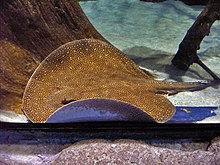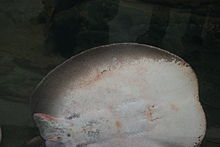Potamotrygonidae
| River stingrays | |
|---|---|

| |
| Ocellate river stingray, Potamotrygon motoro | |
| Scientific classification | |
| Domain: | Eukaryota |
| Kingdom: | Animalia |
| Phylum: | Chordata |
| Class: | Chondrichthyes |
| Subclass: | Elasmobranchii |
| Superorder: | Batoidea |
| Order: | Myliobatiformes |
| Suborder: | Myliobatoidei |
| Superfamily: | Dasyatoidea |
| Family: | Potamotrygonidae Garman, 1877 |
| Type species | |
| Potamotrygon histrix J. P. Müller & Henle, 1841
| |
| Genera | |
River stingrays or freshwater stingrays are
Distribution and habitat
They are native to tropical and
Freshwaters inhabited by members of Potamotrygonidae vary extensively, ranging from
In 2016, two fully marine species formerly included in
Potamotrygonidae are the only family of
Characteristics
River stingrays are almost circular in shape, and range in size from
The upper surface is covered with
Behavior
Feeding
Members of Potamotrygonidae are predators and feed on a wide range of animals such as insects, worms,
Breeding
Like other
Relationship with humans
Sting
Like other
Symptomatology
Accidents occur when the rays are stepped on or when the fins are touched, the defensive behavior consists of turning the body, moving the tail and introducing the stinger into the victim. Generally, stingers are inserted into the feet and heels of bathers and the hands of fishermen. Initial symptoms include severe pain,
As food
Freshwater stingrays are often caught by hook-and-line and as bycatch in trawls. In the Amazon, Paratrygon and certain Potamotrygon are the most caught species and the first is the most sought.[29] In the Río de la Plata region, the meat of P. brachyura is particularly prized and locally the species is called raya fina (fine ray).[30] Freshwater rays weighing less than 2 kg (4.4 lb) are generally discarded, but have a low survival rate.[29] Their meat is mainly consumed locally, but is also exported to Japan and South Korea.[29] From 2005 to 2010, the reported capture in the Brazilian states of Amazonas and Pará has ranged between 584.5 and 1,104.5 metric tons (575.3–1,087.1 long tons) per year.[29] In contrast, some fishers believe they only can be used for traditional medicine, incorrectly thinking that the meat (not just the tail region around the stinger) is toxic.[31]
In captivity

Freshwater stingrays are often kept in aquariums, but require a very large tank and will eat small tank mates.
Several species are commonly bred in captivity, especially at East and Southeast Asian
Conservation

The status of most species is relatively poorly known, but overall it is suspected that river stingrays are declining due to capture (for food and the aquarium industry) and habitat loss (mainly due to dams and pollution from mining).[29]
Zoos and
Dams

Dams represent a risk to some species, but others may benefit from them. For example, the
Fishing and capture
In addition to the large numbers caught for food (hundred of tons per year in the Brazilian Amazon alone),[29] many are killed because of the risk their stings represent to locals and tourists. In the Amazon, it has been estimated that many thousand river stingrays are removed from certain areas to minimize the risk to ecotourism.[7] Such removal is unregulated by the authorities, as not considered fishing in the traditional sense.[7]
Initially Brazil completely banned all exports of wild-caught freshwater stingrays for the aquarium trade, but have since introduced quotas for some species. From 2010 to 2015, between c. 4,600 and 5,700 of six species (the vast majority were
Taxonomy and species
The
Subfamily Styracurinae

- Genus Styracura Carvalho, Loboda & da Silva, 2016
- Styracura pacifica (Beebe & Tee-Van, 1941) (Pacific chupare)
- Styracura schmardae (Werner, 1904) (Chupare stingray)
Subfamily Potamotrygoninae
- Genus Heliotrygon Carvalho & Lovejoy, 2011[44]
- Heliotrygon gomesi Carvalho & Lovejoy, 2011 (Gomes's round ray)
- Heliotrygon rosai Carvalho & Lovejoy, 2011 (Rosa's round ray)

- Genus A. H. A. Duméril, 1865
- Paratrygon aiereba Walbaum, 1792 (Discus ray)
- Paratrygon orinocensis Loboda, Lasso, Rosa & De Carvalho, 2021
- Paratrygon parvaspina Loboda, Lasso, Rosa & De Carvalho, 2021

- Genus Plesiotrygon Rosa, Castello & Thorson, 1987
- , 1987 (Long-tailed river stingray)
- Plesiotrygon nana Carvalho & Ragno, 2011 (Black-tailed antenna ray)
- Genus Potamotrygon Garman, 1877
- Potamotrygon adamastor J. P. Fontenelle & M.R. de Carvalho, 2017[45]
- Potamotrygon albimaculata M. R. de Carvalho, 2016 (Itaituba river stingray, Tapajós river stingray)[3]
- Potamotrygon amandae Loboda & M. R. de Carvalho, 2013[37]
- Potamotrygon amazona J. P. Fontenelle & M.R. de Carvalho, 2017[45]
- Potamotrygon boesemani Rosa, M. R. de Carvalho & Almeida Wanderley, 2008 (Boeseman's river stingray, emperor ray)[46]
- Potamotrygon brachyura (Günther, 1880) (Short-tailed river stingray)
- Potamotrygon constellata (Vaillant, 1880) (Thorny river stingray)
- Potamotrygon falkneri Castex & Maciel, 1963 (Largespot river stingray)
- Potamotrygon garmani J. P. Fontenelle & M.R. de Carvalho, 2017[45]
- Castelnau, 1855) (Bigtooth river stingray)
- Potamotrygon humerosa Garman, 1913
- Potamotrygon histrix (J. P. Müller & Henle, 1834) (Porcupine river stingray)
- Potamotrygon jabuti M. R. de Carvalho, 2016 (Pearl river stingray)[3]
- , 1970 (White-blotched river stingray)
- Potamotrygon limai Fontenelle, J. P. C. B. da Silva & M. R. de Carvalho, 2014[47]
- A. H. A. Duméril, 1865) (Magdalena river stingray)
- Potamotrygon marinae Deynat, 2006
- Potamotrygon marquesi Silva & Loboda, 2019[48]
- Potamotrygon motoro (J. P. Müller & Henle, 1841) (Ocellate river stingray)
- Potamotrygon ocellata (Engelhardt, 1912) (Red-blotched river stingray)
- Castelnau, 1855) (Smoothback river stingray)
- Potamotrygon pantanensis Loboda & M. R. de Carvalho, 2013[37]
- Potamotrygon rex M. R. de Carvalho, 2016 (Great river stingray)[13]
- Potamotrygon schroederi Fernández-Yépez, 1958 (Rosette river stingray)
- Potamotrygon schuhmacheri Castex, 1964 (Parana River stingray)
- Potamotrygon scobina Garman, 1913 (Raspy river stingray)
- Potamotrygon signata Garman, 1913 (Parnaiba River stingray)
- Potamotrygon tatianae J. P. C. B. da Silva & M. R. de Carvalho, 2011
- Potamotrygon tigrina M. R. de Carvalho, Sabaj Pérez & Lovejoy, 2011 (Tiger ray)[49]
- Potamotrygon wallacei M. R. de Carvalho, R. S. Rosa & M. L. G. Araújo, 2016 (Cururu ray)[9]
- Potamotrygon yepezi Castex & Castello, 1970 (Maracaibo River stingray)
See also
References
- ^ )
- ^ a b Duncan, W.P.; M.N. Fernandes (2010). "Physicochemical characterization of the white, black, and clearwater rivers of the Amazon Basin and its implications on the distribution of freshwater stingrays (Chondrichthyes, Potamotrygonidae)". PanamJAS. 5 (3): 454–464.
- ^ PMID 27701358.
- ^ PMID 27470808.
- ^ PMID 27811760.
- ^ Compagno, L. J. V. & S. F. Cook (1995) "The exploitation and conservation of freshwater elasmobranchs: status of taxa and prospects for the future". In: The Biology of Freshwater Elasmobranchs. Oetinger, M. I. & Zorzi, G. D. (eds.). Journal of Aquariculture & Aquatic Sciences, 7: 62–90.
- ^ a b c d Góes de Araújo, M.L.; P. Charvet-Almeida; M.P. Almeida; H. Pereira (2004). "Freshwater Stingrays (Potamotrygonidae): status, conservation and management challenges". Information Document. AC 20 (8): 1–6.
- ^ ISBN 978-0-643-10914-8.
- ^ PMID 27394840.)
{{cite journal}}: CS1 maint: multiple names: authors list (link - ^ Froese, Rainer; Pauly, Daniel (eds.) (2017). "{{{1}}} schmardae" in FishBase. January 2017 version.
- ^ Oddone M.C., Velasco G., Rincon G. (2008). "Occurrence of freshwater stingrays (Chondrichthyes: Potamotrygonidae) in the Uruguay River and its tributaries, Uruguay, South America". International Journal of Ichthyology. 14 (2): 69–76.
{{cite journal}}: CS1 maint: multiple names: authors list (link) - ^ S2CID 52245299.
- ^ PMID 27615813.
- ^ Shibuya, A.; M.L.G. Araújo; J.A.S. Zuanon (2009). "Analysis of stomach contents of freshwater stingrays (Elasmobranchii, Potamotrygonidae) from the middle Negro River, Amazonas, Brazil". Pan-American Journal of Aquatic Sciences. 4 (4): 466–475.
- PMID 27629029.
- ^ .
- S2CID 36752114.
- ^ a b c d e f Bleher, H.yn (13 June 2016). "Definitive guide to South American freshwater rays". Practical Fishkeeping. Retrieved 26 October 2017.
- ^ Wheeler, Quentin (10 April 2011). "New to Nature No 37: Heliotrygon stingrays". The Guardian. Retrieved 25 October 2017.
- S2CID 21482482.
- ^ Froese, Rainer, and Daniel Pauly, eds. (2017). "Potamotrygonidae" in FishBase. January 2017 version.
- ^ Froese, Rainer; Pauly, Daniel (eds.) (2017). "Potamotrygon schuhmacheri" in FishBase. January 2017 version.
- ISBN 1-55297-544-4.
- ^ a b Grenard, S. "Stingray injuries, envenomation, and medical management". potamotrygon.de. Retrieved 22 October 2017.
- ^ PMID 26094699.
- ^ )
- ^ "Freshwater stingray venom varies according to sex and age". AGÊNCIA FAPESP. Retrieved 2020-10-20.
- ^ https://tede.ufam.edu.br/bitstream/tede/2622/1/Juliana%20Luiza%20Varj%C3%A3o%20Lameiras.pdf [bare URL PDF]
- ^ Ministry of the Environment, pp. 1–33
- doi:10.2305/IUCN.UK.2009-2.RLTS.T161687A5480430.en.)
{{cite journal}}: CS1 maint: multiple names: authors list (link - PMID 23895313.
- PMID 16303158.
- ^ "Potamotrygon motoro". SeriouslyFish. Retrieved 27 October 2017.
- .
- ^ "Elasmobranch TAG News" (PDF). Elasmobranch Taxon Advisory Group. 1 March 2017. Retrieved 27 October 2017.
- ^ doi:10.1590/S1679-62252009000400021.)
{{cite journal}}: CS1 maint: multiple names: authors list (link - ^ .
- doi:10.2305/IUCN.UK.2004.RLTS.T39402A10225965.en.)
{{cite journal}}: CS1 maint: multiple names: authors list (link) CS1 maint: numeric names: authors list (link - doi:10.2305/IUCN.UK.2016-1.RLTS.T161385A61472512.en.)
{{cite journal}}: CS1 maint: multiple names: authors list (link - ^ Tuccinardi, M. (21 May 2016). "Rio Negro 'Hystrix' Stingray Gets a Name: Potamotrygon wallacei". Reef to Rainforest Media. Retrieved 26 October 2017.
- ^ a b Listing of the species Potamotrygon motoro and Potamotrygon schroederi in Appendix II in accordance with Article II 2a (b) of the Convention, and Resolution Conf. 9.24 (Rev. CoP15), Sixteenth meeting of the Conference of the Parties Bangkok (Thailand), CITES, 3–14 March 2013, pp. 1–22
- ^ "Appendices I, II and III". CITES. 4 October 2017. Retrieved 26 October 2017.
- ^ "17.246 to 17.249 Freshwater stingrays (Potamotrygonidae spp.)". CITES. Archived from the original on 28 October 2017. Retrieved 26 October 2017.
- ^ a b De Carvalho, M.R.; N.R. Lovejoy (2011). "Morphology and phylogenetic relationships of a remarkable new genus and two new species of Neotropical freshwater stingrays from the Amazon basin (Chondrichthyes: Potamotrygonidae)". Zootaxa (2776): 13–48.
- ^ .
- .
- PMID 24870898.)
{{cite journal}}: CS1 maint: multiple names: authors list (link - PMID 31095730.
- .
- Ross, Richard (1999) Freshwater Stingrays, Aqualog Special,p49
- Ross, Richard (2000) Freshwater Rays, Aqualog, p140
